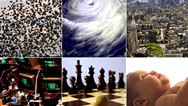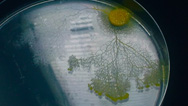Emergence
- Posted 07.10.07
- NOVA scienceNOW
(This video is no longer available for streaming.) The seemingly coordinated movement of a school of fish or a flock of birds is not controlled by any leader. Instead, it emerges naturally as each individual follows a few simple rules, such as go in the same direction as the other guy, don't get too close, and flee any predators. This phenomenon, known as emergence, may someday help experts explain the origin of consciousness and even life itself.
Transcript
EMERGENCE
PBS Airdate: July 10, 2007
NEIL DEGRASSE TYSON: Many people think that the laws of nature and the universe tell us that everything breaks down. Things fall apart, energy wanes, living things grow old and die. Yes, we have some good laws which explain all that, but what about the emergence of life? What about the complexity of life? Where do they come from? Are these rare, miraculous developments? Or is this kind of complexity inevitable, following natural laws we just haven't quite figured out yet?
Correspondent Carla Wohl went looking for the answer.
CARLA WOHL (Correspondent): It is mysterious how a flock of birds or a school of fish move as one, with such grace and coordination, as if there's one brain behind them all or an invisible force at play. An explanation may be found in emergence, a science that tries to explain complex patterns and behavior that arise in the world around us.
Some believe emergence may reveal more than just how birds and fish do this, but how we think and how life itself began in the first place.
But while many of science's mysteries long have been explained—gravity, we predict with Newton's laws of gravity, and magnetism, through Maxwell's laws—but things like this remain largely unpredictable.
JOHN HOLLAND: Emergence, when you first see it, seems mysterious. But then, if I go back and read the papers at the time of Maxwell, electromagnetism seemed very mysterious, too.
CARLA WOHL: Let's start with what we do know about emergence. It's an order we might not expect to see. Usually where there is order, there is a leader—a conductor of an orchestra or a general with his army—orders come from the top, and they go down.
JOHN HOLLAND: Yeah, and they go down.
KEITH STILL (Crowd Dynamics Limited): Top-down order, where you have one brain controlling the functions of the entire group.
CARLA WOHL: A leader at the top and many who follow down below: it's just how we expect things to be.
So who's in charge here? Him? No.
Him? Unh uh.
JOHN HOLLAND: There's no conductor; there's no general.
ROBERT HAZEN: There's no leader. There's no director that's telling every fish where to go.
CARLA WOHL: Well, then what about these birds?
KEITH STILL: There's no one in charge of the birds either.
CARLA WOHL: So if the order isn't coming from the top down, where is it coming from?
JOHN HOLLAND: The organization comes from the bottom up. So, at the bottom, we have these things that are following their own sets of rules, often fairly simple. One is to go in the same direction as the other guys. Another is "Don't get too close, but don't get too far from my neighbors."
CARLA WOHL: And perhaps the most important rule: if someone's coming after you, get out of the way.
From these simple rules, very complex patterns can spontaneously emerge.
JOHN HOLLAND: What we see is a pattern emerging from the bottom up.
CARLA WOHL: And so it came to be called "emergent complexity" or simply, "emergence."
Of course, different creatures have different rules, but whether ants or wildebeests or this slime mold...
JOHN HOLLAND: The behavior emerges from the actions that are controlled by the rules, and behavior of the whole is more than the sum of the parts. And that's the flag for emergence.
CARLA WOHL: And you might not have noticed it, but it's not just seen in animals.
KEITH STILL: Similarly, with crowds; there are no leaders within certain types of crowds.
CARLA WOHL: Crowds of people? We do it just like the birds and fish?
KEITH STILL: Movement is happening at a very much subconscious level. You don't think about how to walk, you just do it.
CARLA WOHL: Keith Still studies the emergent complexity in crowds. He says these people crossing the street have no idea they're part of a larger pattern.
KEITH STILL: As if they're following each other in long conga lines, what happens is that the first individual that finds a gap is being followed by those people that find it easier to follow something that's moving in roughly the right direction than it is to carve their own path through the crowd.
CARLA WOHL: So emergence happens with all kinds of living things that move in groups.
KEITH STILL: It can be a crowd, it can be a flock of birds, a school of fish. These are all emergent phenomena, when you're getting a large-scale order out of a small-scale interaction.
CARLA WOHL: But emergent complexity can be found in non-living things as well.
JOHN HOLLAND: Anything I know that exhibits emergence, involves, a lot of, we might call them agents, a lot of individuals or parts. We could call them parts.
CARLA WOHL: John Holland's first experience with emergence came from some fairly unsophisticated electronic parts that came together to create something almost intelligent. And he saw it a half century ago with a game of checkers.
You used to look at this as child's play, right?
JOHN HOLLAND: Yes, I did.
CARLA WOHL: I believe it's your move, too, by the way.
JOHN HOLLAND: Oh, all right.
CARLA WOHL: What changed your mind?
JOHN HOLLAND: What changed my mind was my encounter at IBM—this was in the early '50s—I was busy at that time simulating neural networks.
CARLA WOHL: Meanwhile, a coworker, Arthur Samuel, was doing something else.
JOHN HOLLAND: He programmed the machine to play checkers. And I thought, "Well, what he's doing is interesting, but that isn't anywhere near as deep as simulating neurons."
CARLA WOHL: It's checkers, right?
JOHN HOLLAND: Yeah, it's checkers.
CARLA WOHL: As it turned out Samuel had achieved something far deeper than anyone at IBM expected.
JOHN HOLLAND: He programmed the rules, and the machine would move according to the rules.
CARLA WOHL: Not only was the computer following the basic rules of checkers, it had another set of rules as well, a strategy to favor moves that might lead to victory.
JOHN HOLLAND: Simply by its experience with him and other players, it favored better moves than he did. That machine learned well enough that it could actually beat Samuel himself. With this learning I have emergence.
CARLA WOHL: It was emergent because when the computer followed simple rules, something as unpredictable and complex as learning emerged, something—until then—only living things could do.
Fifty years later, computers really don't seem to have come all that far.
(Film clip from 2001: A Space Odyssey): Good evening, Dave. How you doing, Hal?
CARLA WOHL: 2001 has come and gone.
(Film clip from 2001: A Space Odyssey): I've wondered whether you might be having some second thoughts about the mission.
CARLA WOHL: Computers were supposed to be having conversations with us, thinking for themselves. So why can't they?
Holland says that's because there's another important factor in emergence to consider: complexity depends on how connected the parts are to each other.
JOHN HOLLAND: Compare the central nervous system, our brain, to a computer. There's a major difference. Each element in a computer, each transistor, contacts, at most, 10 other elements, but in the human brain each individual neuron contacts 10,000 other neurons.
CARLA WOHL: So the sheer number of neurons in our brain, as well as the number of connections between them, is what makes our brain so much more complex than a computer.
JOHN HOLLAND: I've got billions of neurons and each one touching 10,000 others, so we get the emergence and, maybe—some of us believe that—consciousness is one of the emergent phenomena here.
CARLA WOHL: Consciousness? Could something so complex spontaneously emerge from individual parts following simple rules? It may seem counter-intuitive. Many of us think that without a leader or a plan, things become more disordered with time.
ROBERT HAZEN: Our intuition about the world is that things deteriorate, we get old, we die.
CARLA WOHL: Buildings crumble, we expect decay.
ROBERT HAZEN: This is the increase that's inevitable in the universe of disorder.
CARLA WOHL: But if order can emerge from disorder, could we actually expect to see something as complex as life itself emerge?
ROBERT HAZEN: Many of us believe that life follows inevitably as another emergent complex phenomenon.
CARLA WOHL: Bob Hazen, an astrobiologist with the Carnegie Institution is trying to find out if life on Earth emerged from simple molecules arranging themselves into something living.
Hazen hypothesizes that the right molecules, under the right conditions will do this, form increasingly more complex structures, and those complex structures will form even more complex structures and so on, until finally you get life.
To start he needed a simple molecule. He chose pyruvic acid.
ROBERT HAZEN: Pyruvic acid is a good proxy for the kind of simple molecule that would have been abundant on the early Earth. It's colorless, it's basically odorless.
You load it into a gold tube—it's like threading a needle—you then seal this up.
CARLA WOHL: Hazen is trying to reproduce the energy of the heat and pressure deep within the Earth.
ROBERT HAZEN: Typical conditions that might occur in volcanic zones on the floor of the ocean.
Seal this up.
CARLA WOHL: He pressurizes and heats the capsules to 250 degrees centigrade.
ROBERT HAZEN: Just like a pressure cooker.
Emergent complexity takes place in any environment where you have lots of agents coming together, molecules coming together, and energy.
CARLA WOHL: And in a week's time he's re-created the heat and pressure. The one thing missing is water.
ROBERT HAZEN: That's the magic trick. Put it in water, and bingo! Those molecules self-organize into an enclosure—cell-like structures called vesicles, a structure which is essential for life.
CARLA WOHL: So here the agents are molecules. The rules are the rules of chemistry. What emerges is one step closer to something biological, an important first step towards life.
ROBERT HAZEN: And the origin of life must have been a sequence of emergent steps from simplicity to complexity. You go from the simplicity of volcanic gases like carbon dioxide and water to organic molecules.
CARLA WOHL: Still, a vesicle needs to capture energy and nutrients to grow, replicate and divide, before it can truly be a living thing.
And whether these steps are emergent is, for Bob Hazen, the great mystery to be solved.
ROBERT HAZEN: This whole concept of emergent complexity gives us a whole new way of thinking about the universe, going from the simplicity of the earliest universe to the complexity of the modern, living world.
JOHN HOLLAND: Even Hawking says complexity is the study of the 21st century. Maybe in 20 years it'll be the standard science, for all I know.
ROBERT HAZEN: Scientists would love to quantify emergent complexity. We'd love to be able to have a formula that told us what systems become complex, how complex they become.
JOHN HOLLAND: My guess is that we will find some laws that will let us describe some things in these complex adaptive systems, patterns that we can recognize and maybe even make predictions about. And that's the great advantage of Newton, of Maxwell. And maybe someday we'll get our own Maxwell.
Credits
Emergence
- Produced and Edited by
- Vincent Liota
NOVA scienceNOW
- Executive Producer
- Samuel Fine
- Executive Editor
- Neil deGrasse Tyson
- Senior Series Producer
- Vincent Liota
- Supervising Producer
- Stephen Sweigart
- Editorial Producer
- Julia Cort
- Development Producer
- Vinita Mehta
- Senior Editor
- David Chmura
- Post Production Supervisor
- Win Rosenfeld
- Unit Manager
- Candace White
- Associate Producers
- Sarah Kinsella
- Anthony Manupelli
- Shimona Shahi
- Production Assistant
- Alison Snyder
- Production Secretary
- Fran Laks
- Animator
- Brian Edgerton
- Compositor
- Yunsik Noh
- Camera
- James Ball
- Mike Coles
- Mark Daniels
- Brian Dowley
- Bill McMillan
- Clive North
- Sound Recordists
- John Cameron
- Nicolas Dalban
- Paul Flinton
- Bill Heinlein
- George Hitchins
- Kevin Meredith
- Keith Rodgerson
- Ted Roth
- Josh Tallo
- Audio Mix
- Jim Sullivan
- Colorist
- Jim Ferguson
- Animation
- Vincent Liota
- Steve Popplewell
- Additional editing for CERN segment
- Paul Dawe
- Kevin Hanna
- Music
- Rob Morsberger
- Production Manager for CERN Segment
- Selina Kay
- NOVA scienceNOW series animation
- Edgeworx
- Three dimensional brain animation
- Courtesy Dr. Arthur W. Toga, Laboratory of Neuro Imaging at UCLA.
- Archival Material
- Bettmann/CORBIS
- Eric Bailey, Copyright, 2005, Los Angeles Times. Reprinted with permission.
- The Leonard Bernstein Office, Inc.
- Devaki Bhaya, Carnegie Institution
- California Historical Society, FN-25345
- California State Parks, Sutter's Fort Archives
- CERN
- CORBIS
- Denver Public Library, Western History Collection, Z-8843
- IBM Corporate Archives
- Library of Congress
- Steve Mitchell, emedia
- New York Philharmonic
- Courtesy Oregon Parks and Recreation Department, 2006
- Oxford Scientific (OSF)
- Torleif Svensson/CORBIS
- Truckee Donner Historical Society
- Vancouver Public Library, Special Collections
- Special Thanks
- CERN
- David Deamer
- Marco Antonio Delgado Mayordomo
- Alison North - The Rockefeller University Bio-Imaging Resource Center
- Neil deGrasse Tyson
- is director of the Hayden Planetarium in the Rose Center for Earth and Space at the American Museum of Natural History.
- NOVA Series Graphics
- yU + co.
- NOVA Theme Music
- Walter Werzowa
- John Luker
- Musikvergnuegen, Inc.
- Additional NOVA Theme Music
- Ray Loring
- Post Production Online Facility
- The OutPost
- Closed Captioning
- The Caption Center
- NOVA Administrator
- Ashley King
- Publicity
- Eileen Campion
- Anna Lowi
- Yumi Huh
- Lindsay de la Rigaudiere
- Researcher
- Gaia Remerowski
- Production Coordinator
- Linda Callahan
- Unit Manager
- Carla Raimer
- Paralegal
- Raphael Nemes
- Talent Relations
- Scott Kardel, Esq.
- Janice Flood
- Legal Counsel
- Susan Rosen Shishko
- Assistant Editor
- Alex Kreuter
- Associate Producer, Post Production
- Patrick Carey
- Post Production Supervisor
- Regina O'Toole
- Post Production Editor
- Rebecca Nieto
- Post Production Manager
- Nathan Gunner
- Business Manager
- Joseph P. Tracy
- Producers, Special Projects
- Susanne Simpson
- Lisa Mirowitz
- Coordinating Producer
- Laurie Cahalane
- Senior Science Editor
- Evan Hadingham
- Senior Series Producer
- Melanie Wallace
- Managing Director
- Alan Ritsko
- Senior Executive Producer
- Paula S. Apsell
This material is based upon work supported by the National Science Foundation under Grant No. 0229297. Any opinions, findings, and conclusions or recommendations expressed in this material are those of the author(s) and do not necessarily reflect the views of the National Science Foundation.
NOVA scienceNOW is a trademark of the WGBH Educational Foundation
NOVA scienceNOW is produced for WGBH/Boston by NOVA
© 2007 WGBH Educational Foundation
All rights reserved
- Image credit: (fish) © Stephen Frink/CORBIS
Participants
- Neil deGrasse Tyson
- Host of NOVA scienceNOW and Astrophysicist, American Museum of Natural History
- Robert Hazen
- Deep Carbon Observatory
- John Holland
- Santa Fe Institute www.santafe.edu/profiles/?pid=91
- Keith Still
- Crowd Dynamics Ltd. www.crowddynamics.com/Company/G%20Keith%20Still.htm
- Carla Wohl
- Correspondent
Related Links
-

Everyday Examples of Emergence
From bird flock to slime mold, chess to consciousness, see emergence in action all around us.
-

Emergence: Expert Q&A
John Holland of the Santa Fe Institute answers questions about this mysterious phenomenon.
-

Bird Brains
Clues to the origins of human language are turning up in the brains of birds.
-

Slime Mold Smarts
Slime molds may be brainless, but they aren't stupid.



